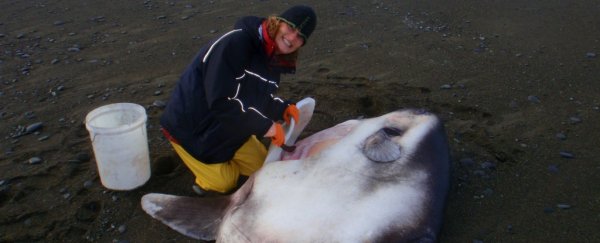For the first time in 130 years, researchers have discovered a new species of sunfish that has escaped taxonomy records for almost three centuries.
The bizarre new species has been named the hoodwinker sunfish (Mola tecta), and has been found in the cold waters of New Zealand, southern Chile, South Africa and the south-east coast of Australia.
"The new species managed to evade discovery for nearly three centuries by 'hiding' in a messy history of sunfish taxonomy, partially because they are so difficult to preserve and study, even for natural history museums," says lead author Marianne Nyegaard from Murdoch University.
"That is why we named it Mola tecta (the hoodwinker sunfish), derived from the Latin tectus, meaning disguised or hidden."
Looking like a cross between a giant pancake and a suitcase with wings, sunfish are the heaviest bony fish in the world. They can weigh up to two tonnes and reach three metres in length.
Despite making regular appearances on YouTube, sunfish are notoriously hard to track down thanks to their solitary nature and preference for living in the hard to reach depths of the ocean. The life of a sunfish is a balancing act between deep-diving for jellyfish and swimming to the surface to warm up.
Their taxonomic history is also a hot mess, with early explorers describing several new species based on single specimens they found whilst sailing. When explorers reached Australia and New Zealand, they began labelling any sunfish they came across as ocean sunfish (Mola mola) which made things even more complicated.
The last time researchers identified a new sunfish species was 130 years ago, which was the Southern ocean sunfish (Mola ramsayi).
But while Nyegaard was studying the population genetics of the Southern ocean sunfish, she noticed there was a genetic difference in the skin samples collected by fisheries in Australia and New Zealand.
"A Japanese research group first found genetic evidence of an unknown sunfish species in Australian waters 10 years ago, but the fish kept eluding the scientific community because we didn't know what it looked like," Nyegaard said in a press release.
The discovery of these mysterious genes sparked the beginning of a four year game of hide and seek with the tricky hoodwinker sunfish. Apart from the genetic evidence, the only clues the team had to go by were a few grainy photos taken by a fisherman.
While these stealthy giants occasionally turn up in commercial fishing nets, fishermen rarely haul these fish on board due to their size.
"Early on, when I was asked if I would be bringing my own crane to receive a specimen, I knew I was in for a challenging – but awesome – adventure," says Nyegaard.
The team's best bet was waiting until a hoodwinker sunfish washed up on beaches in New Zealand and Australia. The team began sorting through sunfish photos on social media to see if they could pick out any unique physical features.
But when Nyegaard studied a photo of a sunfish hauled onto the deck of a fishing boat, she noticed something that set this creature apart from other sunfish.
"I noticed this part on the end of its tail that I hadn't seen on a sunfish before," Nyegaard told ScienceAlert. "I began to wonder if this feature was a unique characteristic of this species, or if it was just something that this particular fish had."
The one day back in May 2014, four sunfish washed onto a beach near Christchurch in New Zealand. When Nyegaard found out, she jumped on a flight from Perth to see the fish for herself.
"A local artist drove me down to the beach in the middle of the night, and he shone the car headlights on this fish," Nyegaard told ScienceAlert. "The puzzle became a picture."
Unlike the other two sunfish species, the hoodwinker sunfish has a smooth, slender body and no protruding snout. Between the upper and lower backfins is a flexible piece of skin connecting the two halves.
But the researchers hadn't finished piecing the puzzle together just yet. After travelling thousands of kilometres and relying on the help of fishermen, locals and museums, the team collected 27 samples from stranded sunfish, which ranged between 50 centimetres to almost two and a half metres.
To confirm that they had discovered an entirely new species, the researchers ploughed through old texts dating back as far as the 16th century. While the old records included colourful descriptions of mermen, sea monsters and several invalid sunfish species, it was clear that the hoodwinker sunfish had managed to slip away from the eyes of taxonomists for almost three centuries.
Now that the hoodwinker's tricks have been revealed, the next steps for Nyegaard and her team are finding out more about its distribution and feeding habits with the help of satellite tagging.
"It's quite humbling to know that the ocean still holds so much mystery," Nyegaard told ScienceAlert. "We tend to think that we know everything, but we still have so many mysteries to unravel."
The research was published in the Zoological Journal of the Linnean Society.
